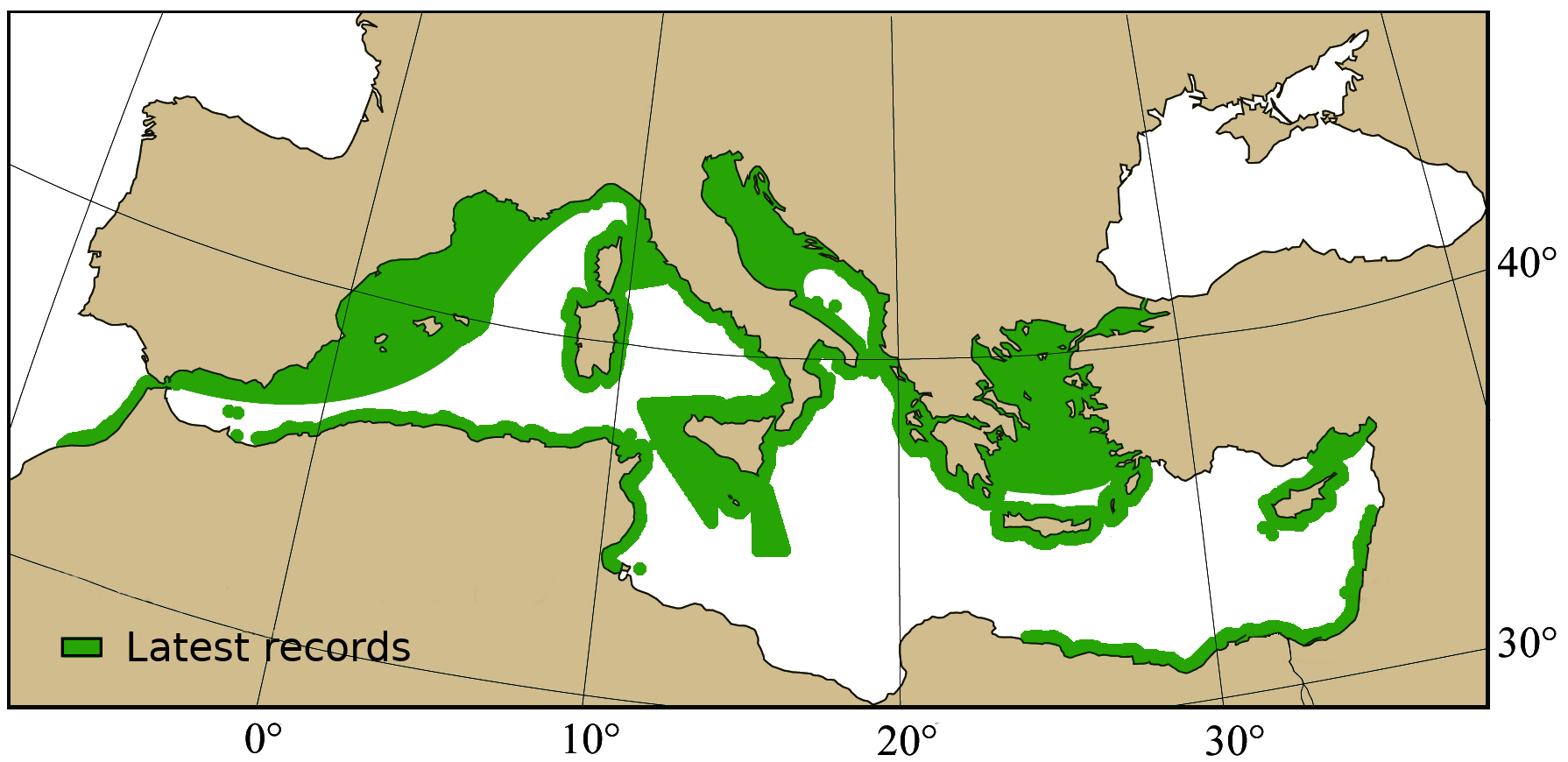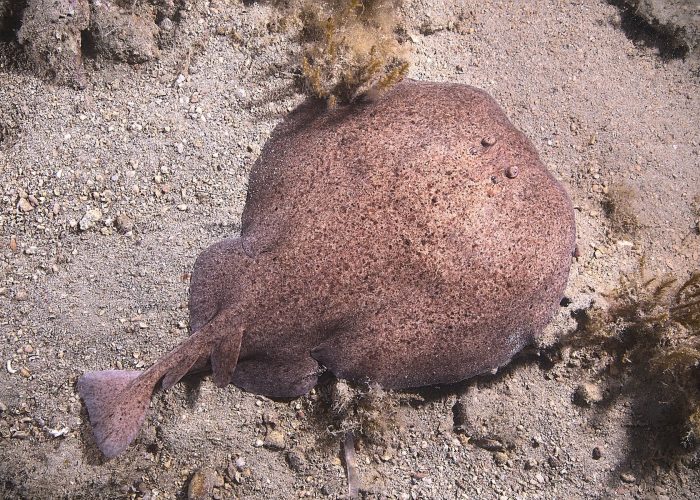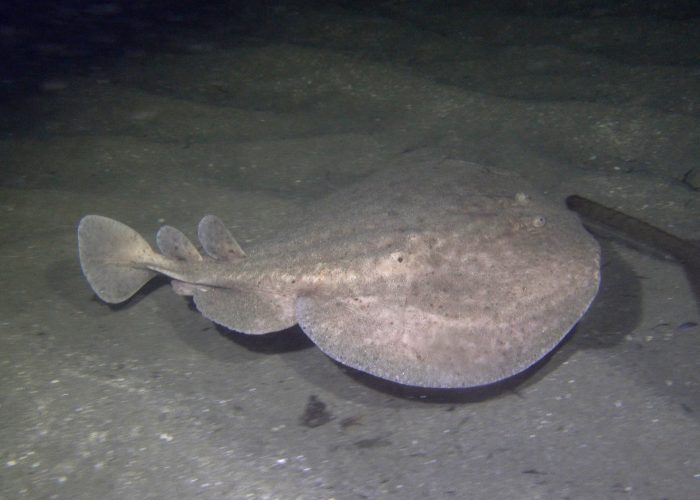Torpedo marmorata
Common name: Marbled torpedo, Marbled Electric Ray, Marbled Torpedo Ray
Order: Torpediniformes
Family: Torpedinidae
Synonyms: None
Misidentifications: None
Short description
Medium to large torpedo ray. Disc thick and nearly circular. Short and thick tail with two dorsal fins (the first one a little more developed than the second). Eyes and spiracles with 6-8 tentacles.
Color: Marbled to speckled coloration with light or dark patterns on a beige to dark brown background.
Measurements:
- Disk width (DW): up to 80 cm (max 100 cm)
- Total length (TL): ~60 cm (max 100 cm)
- Weight: up to 3 kilos
Swimming pattern: Axial-undulatory locomotion.
Biology / Ecology
Feeds on small fishes and also benthic invertebrates. Solitary, nocturnal ambush predator extremely specialized in feeding on bony fishes. Capable of inflicting a severe shock of up to 200 volts for attack and defense.
Behaviour: Solitary.
Reproduction: Viviparous (aplacental viviparity with histotrophy). Size at maturity (TL): 40 cm female at 12 years, 29 cm male at 5 years. Gestation period of about 9-12 months from November to December. Juveniles per litter: 2-32 (size-dependent of the female). Size at birth (TL): 10-14 cm.
Habitat: Benthic on soft bottoms, rocky reefs and seagrass areas, with a wide depth distribution from the surface to depths of about 300 m. Avoids temperatures above 20°C. Found to a depth of 1480m.
Difficult to distinguish from Torpedo sinuspersici (a recent arrival from the Red Sea).
Distinguishing characteristics
- Marbled and speckled patterns
Torpedinidae: Greatly enlarged pectoral fin. Large oval-shape disc. Electric organ on each side of the head.
Distribution
Worldwide: Eastern Atlantic, from North Sea to South Africa. Absent from Black Sea.
Mediterranean: Whole Mediterranean, with higher densities in the western areas.
- Occurrence: Abundant/Occasional.
- Last records: Malta (2023), Cyprus (2018-2022), Sicily (2017), Spain (2015), Catalan Sea and Gulf of Lion (2013), Lebanon (2013), Marmara Sea (2013), Aegean Sea (2014), Balearic Sea (2009), Iskenderun Bay – Turkey (2010-2011), Tunisia (2009), Adriatic (2008), Tuscan coast (2004), Algeria (2003), Egypt (1994).

Any recent observation not on the map?
Contact us!
Conservation
Threats: Taken as bycatch in demersal trawl, longline, set net, and coastal trammel net fisheries across its range. Often discarded in the Mediterranean.
Protection level:
- Mediterranean: Least Concern (IUCN 2016, last assessment: 2016)
- Europe: Least Concern (IUCN 2015, last assessment: 2014)
- Global: Vulnerable (IUCN 2021, last assessment: 2020)
Key references
- Abdel-Aziz S.H. 1994. Observations on the biology of the common torpedo (Torpedo torpedo, Linnaeus, 1758) and marbled electric ray (Torpedo marmorata, Risso, 1810) from Egyptian Mediterranean waters. Marine and Freshwater Research 45(4): 693-704.
- Agius A., Borg J. A., Schembri P. J. 2024. Batoid fishes associating with tuna farms in Malta. Rapp. Comm. int. Mer Médit. 43: 273.
- Bellodi A., Mulas A., Carbonara P., Cau A., Cuccu D., Marongiu M. F., Mura V., Pesci P., Zupa W., Porcu C., Follesa, M.C. 2021. New insights into life–history traits of Mediterranean Electric rays (Torpediniformes: Torpedinidae) as a contribution to their conservation. Zoology 146: 125922.
- Carpentieri P., Nastasi A., Sessa M., Srour A. 2021. Incidental catch of vulnerable species in Mediterranean and Black Sea fisheries – A review. General Fisheries Commission for the Mediterranean. Studies and Reviews 101: I-317.
- Chatzispyrou A., Gubili C., Touloumis K., Karampetsis D., Kioulouris S., Anastasopoulou A., Christidis A., Peristeraki P., Batjakas I.E., Koutsikopoulos C. 2021. Life-history traits of the marbled electric ray, Torpedo marmorata Risso, 1810, from the Greek Seas, north-eastern Mediterranean Sea. Environmental Biology of Fishes 104(12): 1575-1592.
- Consalvo I., Scacco U., Romanelli M., Vacchi M. 2007. Comparative study on the reproductive biology of Torpedo torpedo (Linnaeus, 1758) and T. marmorata (Risso, 1810) in the central Mediterranean Sea. Scientia Marina 71(2): 213-222.
- Damalas D., Vassilopoulou V. 2011. Chondrichthyan by-catch and discards in the demersal trawl fishery of the central Aegean Sea (Eastern Mediterranean). Fisheries Research 108(1): 142-152.
- Duman Ö. V., Başusta, N. 2013. Age and growth characteristics of marbled electric ray Torpedo marmorata (Risso, 1810) inhabiting Iskenderun Bay, North-eastern Mediterranean Sea. Turkish Journal of Fisheries and Aquatic Sciences 13(3).
- Follesa M. C., Marongiu M. F., Zupa W., Bellodi A., Cau A., Cannas R., Colloca F., Djurovic M., Isajlovic I., Jadaud A., Manfredi C., Mulas A., Peristeraki P., Porcu C., Ramirez-Amaro S., Salmerón Jiménez F., Serena F., Sion L., Thasitis I., Cau A., Carbonara P. 2019. Spatial variability of Chondrichthyes in the northern Mediterranean. Scientia Marina 83(S1): 81-100.
- Giovos I., Serena F., Katsada D., Anastasiadis A., Barash A., Charilaou C., Hall-Spencer J.M.,Crocetta F.,Kaminas A., Kletou D, Maximiadi M., Minasidis V., Moutopoulos D.K., Aga-Spyridopoulou R.N., Thasitis I., Kleitou P. 2021. Integrating literature, biodiversity databases, and citizen-science to reconstruct the checklist of Chondrichthyans in Cyprus (Eastern Mediterranean Sea). Fishes 6(3): 24.
- O’Keefe M., Bengil EG., Palmer JL, Beton D, Çağlar Ç., Godley B.J, Özkan M., Snape R.T.E., Broderick A.C. 2023. Diversity and distribution of elasmobranchs in the coastal waters of Cyprus: using bycatch data to inform management and conservation. Front. Mar. Sci. 10: 1181437.
- Ramírez-Amaro S., Ordines F., Esteban A., García C., Guijarro B., Salmerón F., Terrasa B., Massutí E. 2020. The diversity of recent trends for chondrichthyans in the Mediterranean reflects fishing exploitation and a potential evolutionary pressure towards early maturation. Scientific Reports 10(1): 1-18.



